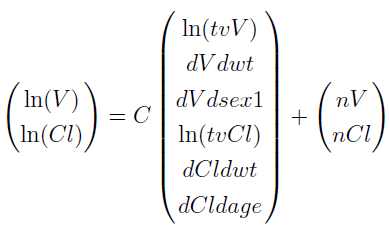The idea of a C matrix can be found on page 9 in reference [21]. Michael Dunlavey initially implemented it for Phoenix [22]. The following example model will be used as an illustration.
PK01Co3 Covariate Model_sexcov
1 test(){
2 fMicro(A1, Cl / V)
3 dosepoint(A1)
4 C = A1 / V
5 error(CEps = 0.0943516830098015)
6 observe(CObs = C * (1 + CEps))
7 stparm(V = tvV * (wt/75)^dVdwt * exp(dVdsex1*(sex==1)) * exp(nV))
8 stparm(Cl = tvCl * (wt/75)^dCldwt * (age/40)^dCldage * exp(nCl))
9 fcovariate(sex())
10 fcovariate(wt)
11 fcovariate(age)
12 fixef(tvV = c(, 9.89123212145973, ))
13 fixef(tvCl = c(, 0.143535800174327, ))
14 fixef(dVdwt(enable=c(0)) = c(, 0.934629940746843, ))
15 fixef(dCldwt(enable=c(1)) = c(, 0.863337125567972, ))
16 fixef(dCldage(enable=c(2)) = c(, -0.46484604620388, ))
17 fixef(dVdsex1(enable=c(3)) = c(, 1, ))
18 ranef(diag(nV, nCl) = c(0.1061485, 0.079772633))
19 }In this model, there are two random effects nV and nCl (so the C matrix will have two rows). These effects are paired with corresponding typical parameters, tvV and tvCl, and associated with corresponding structural parameters V and Cl. There are three covariates (sex, wt, and age) and four covariate parameters (dVdwt, dVdsex1, dCldwt, dCldage. From this model:
V = exp{ln(tvV) + dVdwt × ln(wt/75) + dVdsex1 × (sex == 1) + nV}
Cl = exp{ln(tvCl) + dCldwt × ln(wt/75) + dCldage × ln(age/40) + nCl}
After a ln transformation on both side for V and Cl:
ln(V) = ln(tvV) + dVdwt × ln(wt/75) + dVdsex1 × (sex == 1) + nV
ln(Cl) = ln(tvCl) + dCldwt × ln(wt/75) + dCldage × ln(age/40) + nCl
On the right-hand side, the random effects parameter nV and nCl, the typical parameters tvV and tvCl, and four covariate parameters dVdwt, dVdsex1, dCldwt, dCldage, are all linearized. In a matrix form:

where the C matrix is the 2 by 6 matrix
